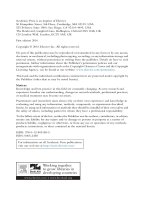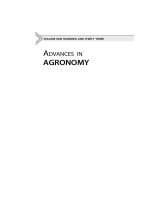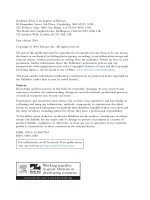Advances in accounting volume 23
Bạn đang xem bản rút gọn của tài liệu. Xem và tải ngay bản đầy đủ của tài liệu tại đây (1.69 MB, 333 trang )
www.ebook3000.com
ADVANCES IN ACCOUNTING
ADVANCES IN ACCOUNTING
Series Editor:
Philip M. J. Reckers
Volumes 13–22:
Edited by Philip M. J. Reckers
www.ebook3000.com
ADVANCES IN ACCOUNTING VOLUME 23
ADVANCES IN ACCOUNTING
EDITED BY
PHILIP M. J. RECKERS
PAB Professor of Accountancy
Arizona State University, USA
CO-EDITOR
GOVIND IYER
Arizona State University, USA
ASSOCIATE EDITORS
SALVADOR CARMONA
Instituto de Empresa, Spain
ERIC JOHNSON
Indiana University, USA
LOREN MARGHEIM
University of San Diego, USA
RICHARD MORTON
Florida State University, USA
Amsterdam – Boston – Heidelberg – London – New York – Oxford
Paris – San Diego – San Francisco – Singapore – Sydney – Tokyo
JAI Press is an imprint of Elsevier
JAI Press is an imprint of Elsevier
Linacre House, Jordan Hill, Oxford OX2 8DP, UK
Radarweg 29, PO Box 211, 1000 AE Amsterdam, The Netherlands
525 B Street, Suite 1900, San Diego, CA 92101-4495, USA
First edition 2008
Copyright r 2008 Elsevier Ltd. All rights reserved
No part of this publication may be reproduced, stored in a retrieval system
or transmitted in any form or by any means electronic, mechanical, photocopying,
recording or otherwise without the prior written permission of the publisher
Permissions may be sought directly from Elsevier’s Science & Technology Rights
Department in Oxford, UK: phone (+44) (0) 1865 843830; fax (+44) (0) 1865 853333;
email: Alternatively you can submit your request online by
visiting the Elsevier web site at and selecting
Obtaining permission to use Elsevier material
Notice
No responsibility is assumed by the publisher for any injury and/or damage to persons
or property as a matter of products liability, negligence or otherwise, or from any use
or operation of any methods, products, instructions or ideas contained in the material
herein. Because of rapid advances in the medical sciences, in particular, independent
verification of diagnoses and drug dosages should be made
British Library Cataloguing in Publication Data
A catalogue record for this book is available from the British Library
ISBN: 978-0-7623-1425-6
ISSN: 0882-6110 (Series)
For information on all JAI Press publications
visit our website at books.elsevier.com
Printed and bound in the United Kingdom
08 09 10 11 12 10 9 8 7 6 5 4 3 2 1
www.ebook3000.com
CONTENTS
ix
LIST OF CONTRIBUTORS
xiii
EDITORIAL BOARD
STATEMENT OF PURPOSE AND REVIEW
PROCEDURES
EDITORIAL POLICY AND MANUSCRIPT FORM
GUIDELINES
THE EFFECT OF INNOVATIVE ACTIVITY ON
FIRM PERFORMANCE: THE EXPERIENCE OF
TAIWAN
Asokan Anandarajan, Chen-Lung Chin,
Hsin-Yi Chi and Picheng Lee
AN EXAMINATION OF FACTORS ASSOCIATED
WITH THE TYPE AND NUMBER OF INTERNAL
CONTROL DOCUMENTATION FORMATS
James Bierstaker, Diane Janvrin and
D. Jordan Lowe
RE-DEFINING ‘‘MATERIALITY’’: AN EXERCISE TO
RESTORE ETHICAL FINANCIAL REPORTING
Govind Iyer and Stacey Whitecotton
v
xv
xvii
1
31
49
vi
CONTENTS
EFFECTS OF SUBORDINATE LIKEABILITY
AND BALANCED SCORECARD FORMAT
ON PERFORMANCE-RELATED
JUDGMENTS
Steven E. Kaplan, Michael J. Petersen and
Janet A. Samuels
85
THE MODERATING EFFECT OF MANAGER’S
ETHICAL JUDGMENT ON THE RELATIONSHIP
BETWEEN BUDGET PARTICIPATION AND
BUDGET SLACK
Adam S. Maiga and Fred A. Jacobs
113
AN EXAMINATION OF FIRST CALL’S
COMPANY ISSUED GUIDANCE DATABASE
Lynn Rees and Rebecca Wynalda
147
THE INFORMATION CONTENT OF REVERSE
STOCK SPLITS
Dahlia Robinson
179
NEW EVIDENCE ON AUDITOR INDEPENDENCE
POLICY
Philip M. J. Reckers and Dahlia Robinson
207
FINANCIAL REPORTING PRACTICES OF FAMILY
FIRMS
Yen H. Tong
231
www.ebook3000.com
Contents
vii
FINANCIAL REPORTING FACTORS AFFECTING
DONATIONS TO CHARITABLE ORGANIZATIONS
John M. Trussel and Linda M. Parsons
263
THE VALUE-RELEVANCE OF NONFINANCIAL
INFORMATION: THE BIOTECHNOLOGY INDUSTRY
Ya-wen Yang
287
This page intentionally left blank
www.ebook3000.com
LIST OF CONTRIBUTORS
Asokan Anandarajan
School of Management, New Jersey
Institute of Technology, Newark, NJ,
USA
James Bierstaker
Department of Accountancy, Villanova
School of Business, Villanova University,
Villanova, PA, USA
Hsin-Yi Chi
Department of Accounting, National
Taichung Institute of Technology,
Taichung City, Taiwan
Chen-Lung Chin
Department of Accounting, National
Chengchi University, Taipei City, Taiwan
Govind Iyer
W. P. Carey School of Business, Arizona
State University, Tempe, AZ, USA
Fred A. Jacobs
Lulea˚ University of Technology,
Accounting and Control, Department of
Business Administration and Social
Sciences, Lulea˚, Sweden
Diane Janvrin
Department of Accounting, College of
Business, Iowa State University, Ames,
IA, USA
Steven E. Kaplan
School of Accountancy, W.P. Carey
School of Business, Arizona State
University, Tempe, AZ, USA
Picheng Lee
Department of Accounting, Lubin School
of Business, Pace University, New York,
USA
ix
x
LIST OF CONTRIBUTORS
D. Jordan Lowe
Accounting Department, School of
Global Management and Leadership,
Arizona State University, Glendale, AZ,
USA
Adam S. Maiga
School of Accounting, College of
Business Administration, Florida
International University, Miami, FL,
USA
Linda M. Parsons
University of Alabama, Culverhouse
School of Accountancy, Tuscaloosa, AL,
USA
Michael J. Petersen
W.P. Carey School of Business, Arizona
State University, Tempe, AZ, USA
Philip M. J. Reckers
W.P. Carey School of Business, School of
Accountancy, Arizona State University,
Tempe, AZ, USA
Lynn Rees
Department of Accounting, Mays
Business School, Texas A&M University,
College Station, TX, USA
Dahlia Robinson
College of Business Administration,
University of South Florida, Tampa, FL,
USA
Janet A. Samuels
Accounting Department, School of
Global Management and Leadership,
Arizona State University, Glendale, AZ,
USA
Yen H. Tong
Division of Accounting, Nanyang
Business School, Nanyang Technological
University, Singapore
John M. Trussel
The Pennsylvania State University at
Harrisburg, School of Business
Administration, Middletown, PA, USA
Stacey Whitecotton
W. P. Carey School of Business, Arizona
State University, Tempe, AZ, USA
www.ebook3000.com
List of Contributors
xi
Rebecca Wynalda
Department of Accounting, Mays
Business School, Texas A&M University,
College Station, TX, USA
Ya-wen Yang
Department of Accounting, University of
Miami, Coral Gables, FL, USA
Philip M. J. Reckers
Series Editor
This page intentionally left blank
www.ebook3000.com
EDITORIAL BOARD
M. J. Abdolmohammadi
Bently College
Venkataraman Iyer
North Carolina at Greensboro
Mark Anderson
University of Texas at Dallas
Peter Johnson
Brigham Young University
Vairam Arunachalam
University of Missouri-Columbia
Khondkar E. Karim
Rochester Institute of Technology
Alan Bathke
Florida State University
Tim Kelley
University of San Diego
Bruce Branson
North Carolina State University
Inder K. Khurana
University of Missouri
Anthony H. Catanach Jr.
Villanova University
Picheng Lee
Pace University
William Dilla
Iowa State University
Chao-Shin Liu
University of Notre Dame
Cindy Durtschi
Florida State University
Thomas Lopez
University of South Carolina
Robert Greenberg
Washington State University
Kenneth Lorek
Northern Arizona University
Thomas Hall
University of Texas-Arlington
D. Jordan Lowe
Arizona State University-West
John M. Hassell
Indiana University
H. Fred Mittelstaedt
University of Notre Dame
William Hillison
Florida State University
Carl Pacini
Florida Gulf Coast University
xiii
xiv
EDITORIAL BOARD
Don Pagach
North Carolina State University
David B. Smith
University of Nebraska
Kurt Pany
Arizona State University
Rajendra P. Srivastava
University of Kansas
William Pasewark
University of Houston
Tom Stober
University of Notre Dame
Robert Ramsay
University of Kentucky
David Stout
Youngstown State University
H. Sami
Temple University
Sandra Vera-Munoz
University of Notre Dame
Debra Sanders
Washington State University
Stephen W. Wheeler
University of the Pacific
Arnold Schneider
Georgia Institute of Technology
Bernard Wong-On-Wing
Washington State University
Richard Schroeder
University of North
Carolina-Charlotte
Philip M. J. Reckers
Series Editor
www.ebook3000.com
STATEMENT OF PURPOSE AND REVIEW
PROCEDURES
Advances in Accounting (AIA) is a research series publication providing
academics and practitioners a forum to address current and emerging issues
in accounting. Manuscripts may embrace any research methodology and
examine any accounting-related subject. Manuscripts may range from
empirical to analytical; timely replications will be considered. Manuscripts
must be readable, relevant, and reliable. To be readable, manuscripts must
be understandable and concise. To be relevant, manuscripts must be related
to problems facing the accounting and business community. To be reliable,
conclusions must follow logically from the evidence and arguments
presented. For empirical reports, sound research design and execution are
critical. For theoretical treatises, reasonable assumptions and logical
developments are essential.
REVIEW PROCEDURES
AIA intends to provide authors with timely reviews clearly indicating the
acceptance status of their manuscripts. The results of initial reviews
normally will be reported to authors within 90 days from the date the
manuscript is received. All manuscripts are blind reviewed by two members
of the editorial board and an Associate Editor. Editorial correspondence
pertaining to manuscripts should be sent to the editor. A $75 submission fee
is required.
Editorial correspondence pertaining to manuscripts should be sent to:
Philip M. J. Reckers
School of Accountancy & Information Management
W. P. Carey School of Business
Arizona State University
Box 873606
Tempe, AZ 85287-3606
xv
Philip M. J. Reckers
Series Editor
www.ebook3000.com
EDITORIAL POLICY AND MANUSCRIPT
FORM GUIDELINES
1. Manuscripts should be typewritten and double-spaced on 8½ by 11
white paper. Only one side of a page should be used. Margins should be
set to facilitate editing and duplication except as noted:
a. Tables, figures, and exhibits should appear on a separate page. Each
should be numbered and have a title.
b. Footnotes should be presented by citing the author’s name and the
year of publication in the body of the text; for example, Schwartz
(1989); Lowe, Reckers and Whitecotton (2002).
2. Manuscripts should include a cover page which indicates the author’s
name and affiliation.
3. Manuscripts should include on a separate lead page an abstract not
exceeding 200 words. The author’s name and affiliation should not
appear on the abstract.
4. Topical headings and subheadings should be used. Main headings in the
manuscript should be centered, secondary headings should be flushed
with the left hand margin. (As a guide to usage and style, refer to
William Strunk, Jr., and E.B. White, The Elements of Style.)
5. Manuscripts must include a list of references which contains only those
works actually cited. (As a helpful guide in preparing a list of references,
refer to Kate L. Turabian, A Manual for Writers of Term Papers,
Theses, and Dissertations.)
6. In order to be assured of an anonymous review, authors should not
identify themselves directly or indirectly. Reference to unpublished
working papers and dissertations should be avoided. If necessary,
authors may indicate that the reference is being withheld for the reasons
cited above.
7. Accepted manuscripts ultimately must be submitted on disk or CD.
8. Manuscripts currently under review by other publications should not be
submitted. Complete reports of research presented at a national or
regional conference of a professional association and ‘‘State of the Art’’
papers are acceptable.
xvii
xviii
EDITORIAL POLICY
9. Electronic submission of manuscripts is encouraged; send in WORD
document form to Copies of any and all
research instruments should also be included. Alternatively, four paper
copies of each manuscript may be submitted to the Editor-In-Chief.
10. The author should send a check by mail for $75.00 made payable to
Advances in Accounting as a submission fee to:
Philip M. J. Reckers
Series Editor
www.ebook3000.com
THE EFFECT OF INNOVATIVE
ACTIVITY ON FIRM
PERFORMANCE: THE EXPERIENCE
OF TAIWAN
Asokan Anandarajan, Chen-Lung Chin, Hsin-Yi Chi
and Picheng Lee
ABSTRACT
Firm performance is, among other factors, a function of tangible and
intangible assets that the firm possesses and utilizes to maximize value.
While research has examined the impact of advertising and R&D on firm
performance, in this chapter we, in addition, examine the extent of
innovation as measured by patents granted on firm performance. Our
findings indicate that overall, innovative activity as measured by number
of patents granted, significantly influences firm performance as measured
by Tobin’s q. Hence patenting activity is value relevant to investors.
Further, this relationship is more pronounced when the patents are
granted in the United States. We conclude that markets tend to give
greater credence to innovative activity when patents are granted to foreign
firms by the U.S. Patenting Office. Finally, the stage of the product in the
industry chain moderates the influence of patenting activity on firm
performance. When patents are granted in the design stage the impact on
firm performance is stronger relative to when patents are granted in the
Advances in Accounting, Volume 23, 1–30
Copyright r 2008 by Elsevier Ltd.
All rights of reproduction in any form reserved
ISSN: 0882-6110/doi:10.1016/S0882-6110(07)23001-9
1
2
ASOKAN ANANDARAJAN ET AL.
manufacturing and packaging and testing stages. The evidence indicates
that patents by companies in the manufacturing end of the chain have a
more pronounced impact on firm performance relative to patents granted
in the packaging and testing stage.
1. INTRODUCTION
Much research has been conducted on the association of innovative activity
and firm performance. Sher and Yang (2005) define innovative activity as any
incremental or radical change in technology embodied in product and
process. Innovative activity is seen as critical to a firm in achieving strategic
competitiveness (Conner, 1991). Hitt, Hoskisson, and Ireland (1994) and
Zahra, Ireland, and Hitt (2000) note that innovations enable a firm to offer a
greater variety of significantly differentiated products and therefore should
lead to a higher level of financial performance. While innovative activity is a
difficult construct to measure, in this study it is measured by the number of
patents granted to a firm both in Taiwan and the United States. This is
because innovation or inventiveness, as represented by intellectual property
rights, is protected by national patent offices within national borders meaning
that a patent protects an idea in one country and in one market. This idea
cannot be copied by other firms in that country; this ensures that the result is
not confounded by commercial activities of other firms (e.g. Grupp &
Schmoch, 1999). Measures based on patents granted to a firm have been also
considered to be a better and more reliable indicator of the technological
competitiveness of the firm in the prior literature (see Pegels & Thirumurthy,
1996; Watanabe, Tsuji, & Griffy-Brown, 2001).
The first objective of this chapter is to investigate whether patents granted
in Taiwan and in the United States for Taiwanese semiconductor firms have
a differential impact on firms’ performance as measured by Tobin’s q.1 This
study builds on the findings of Shane and Klock (1997) and Chin, Lee, Chi,
and Anandarajan (2006) that patenting activity in the U.S. (refer Shane &
Klock) and in Taiwan (refer Chin et al.) is viewed by the market as evidence
of innovation and is positively associated with increase in firm value. In this
respect, our study is a trangulation of the Shane and Klock and Chin et al.
studies. Watanabe et al. (2001) state that patent applications to foreign
countries, in particular the United States, provide a better demonstration of
innovational ability; in particular the frequency or number of patent
applications in the United States is, according to them, a strong indicator of
www.ebook3000.com
The Effect of Innovative Activity on Firm Performance
3
inventive ability. In addition, they note that patents granted by the United
States Patent and Trademark Office (USPTO) enhance a firm’s visibility
and exposure. Therefore, in our study, we expect patents granted in the
United States to send a stronger signal and have a greater influence on firm
performance relative to patents granted in Taiwan.
The second objective of this chapter is to examine whether the stage of a
product’s life cycle in the semiconductor industry moderates the association
between patenting activity and firm performance as measured by Tobin’s q.
We especially examine if the moderating influence is accentuated by location
of patent filing (Taiwan versus United States). Semiconductor products
include discrete devices, optoelectronics, and integrated circuits, with the last
of these accounting for the bulk of all semiconductors. The semiconductor
industry was selected for the current study because of the strategic importance
of intangible capital such as patents in this segment of the electronics
industry.2 Hall and Ziedonis (2001) indicate that the semiconductor industry
provides an excellent setting within which to examine the association of
patent activity and a firm’s ‘‘rapidly advancing and cumulative technology’’
(p. 102). In the United States products of firms in the semiconductor industry
go through several stages, namely, design, manufacturing, and packaging and
testing. In Taiwan, semiconductor firms specialize in one of the above valueadded activities, namely, either design or manufacturing or packaging and
testing. Hence, while prior studies focus more on the association between
patent and firm’s performance, our study provides a unique opportunity to
examine how the stage of the industry value chain moderates the association
between extent of patenting activity and Tobin’s q. We examine whether the
impact of patenting activity on firm performance is influenced by the different
stages in the semiconductor industry value chain.
In this study, firm performance is measured using Tobin’s q. Tobin (1978)
argues that q is a measure of profitable investment opportunities. Tobin’s q
was selected in this study as the dependent variable to surrogate for firm
performance because it has been used extensively in the literature (e.g. Jaffe,
1986; Shane & Klock, 1997; Bharadwaj, Bharadwaj, & Konsynski, 1999).
For the purpose of sensitivity analysis, in addition to frequency of patents
granted, we also use another measure, namely, value of patents. We estimated
patent values using the Cobb–Douglas production function as used by
Seethamraju (2003) and estimated the value of each patent at different value
chain stages. We re-conducted our tests using this measure and our results
remained unchanged.
Our empirical findings, based on 279 Taiwan semiconductor firm-year
observations covering the period of 1990–2002, indicate that patents granted
4
ASOKAN ANANDARAJAN ET AL.
in the United States exert greater influence than those in Taiwan on firm
performance as measured by Tobin’s q. In addition, patents filed in the
design sector have greater influence on performance relative to patents filed
in other sectors. We also find that the estimated values of patents are higher
for the firms in the design sector relative to the firms in the other sectors,
consistent with previous market-based results.
This chapter is different from prior research and contributes to the
literature on the association between patenting activity and Tobin’s q in two
respects. First, we examine the influence of extent of patenting activity
(surrogating for innovation) for firms in Taiwan. Most of the research in this
area has been conducted in the United States. This research is important
because we show whether the association between patent filing and Tobin’s q
also holds in environments other than that of the United States. If the same
relationship holds we can conclude that the general theory is not merely
limited to the United States but has external validity. We find that the
moderating influence of industry on the association between patenting
activity and firm performance is magnified by location of patent filing. The
moderating influence is stronger in the United States relative to Taiwan.
Second, this moderating influence also applies to the different stages of the
value chain in the semiconductor industry.
In the accounting literature this study contributes to the specific niche in
financial accounting research that focuses on the value relevance of nonfinancial information to investors. This particular niche in financial
accounting research has gained in importance because Brown and Lys
(1999) documented a long-term decline in the value relevance of financial
statement information as an important determinant in the market’s valuation
of a firm. Francis and Schipper (1999) noted the importance of research
examining non-financial factors that could potentially have value relevance
for investors in the light of ‘‘financial statements losing a significant portion
of their relevance for investors’’. In this field, Amir and Lev (1996) found that
population size and market penetration were highly value relevant. Hirschey,
Richardson, and Scholz (2001) studied 199 U.S. high-tech firms and pointed
out that non-financial information was particularly relevant in the hightechnology sector where productivity was a vital determinant of long-term
success. They concluded a positive association noting that ‘‘non-financial
information concerning the quality of inventive output appears to sharpen
the investors’ perception of the on going value created by the firm’s inventive
and innovation activity’’. This chapter contributes to the literature on value
of non-financial information by building on the Hirshey et al. study and
examining the association of patenting activity with firm value in a different
www.ebook3000.com
The Effect of Innovative Activity on Firm Performance
5
environment. Our finding that patenting activity is value relevant enhances
the external validity of the Hirschey et al. findings in the global environment.
Our findings also show that value relevance of non-financial information
(as surrogated by patenting activity) is contingent on the position of the firm
in the value chain.
Finally, this chapter contributes to a niche in management accounting
literature, namely, research focusing on value chain relationships. This line of
study focuses on the added value of each step in a firm’s value chain. Shank
and Govindarajan (1992) used a case study representing the paper products
industry to show how costs can be analyzed along the value chain to
determine value added in each stage of the chain. Dekker (2003) conducted a
similar analysis with Sainsbury’s, a large United Kingdom retailer. Chang
and Hwang (2002) examined the value chain of 65 U.S. and 34 Hong Kong
companies. They found that U.S. companies invested most of their resources
in upstream activities relative to their Hong Kong counterparts. In this study
we also contribute to the value chain literature in management accounting by
showing specifically that, in the high-tech industry, innovative activity at the
upstream end of the value chain magnifies perceptions of added value relative
to innovative activities downstream.
Our chapter is presented as follows. In Section 2 we discuss the semiconductor industry. In Section 3 we present the results of prior studies in this
area. We develop our hypotheses in Section 4. We discuss our sample in
Section 5 and our overall methodology and regression equations in Section 6.
Section 7 presents our conclusions.
2. THE SEMICONDUCTOR INDUSTRY
2.1. The Industry in General
Overall, the semiconductor industry is characterized by continuous
innovation and has advanced exponentially since its inception in the middle
of the twentieth century. The percentage share of semiconductors in global
electronics production rose from 2% to 3% in the 1960s to just fewer than
10% in the 1980s and currently is expected to rise to between 25% and 30%.
The electronics industry is composed of ‘‘upstream’’ and ‘‘downstream’’
sectors. Semiconductors, and other parts and components, are in upstream
sectors; consumer electronics, telecommunications, and information technology products are in the downstream sectors. The semiconductor industry
6
ASOKAN ANANDARAJAN ET AL.
can also be divided into four core businesses based on production stages
(design, manufacturing/fabrication, packaging, and testing). The four core
businesses have different characteristics. The design business is knowledge
intensive and requires little capital fabrication technology; fabrication is
capital intensive, while packaging and testing are both labor intensive in
nature. Each sector, however, adds value to the final products that are fed
into the downstream sector.
2.2. The Industry in Taiwan
The electronics industry has become the most dynamic sector in East Asia in
the last two decades. The region as a whole has exported huge volumes of
PCs, disk drives, semiconductors, televisions, and telephones. The commencement of semiconductor production in Taiwan dates back to the 1960s.
In 1966, General Instruments of the United States set up the first semiconductor plant in Taiwan. Other firms followed suit. In the 1970s, the
government decided to stimulate indigenous production capacity in semiconductors with a view to upgrading the overall technological level. Chen
(2002) in an overview noted that the development of the semiconductor
industry in Taiwan was the result of a strategy of vertical disintegration
which, in turn, facilitated the formation of local and cross-border linkages in
pursuit of industrial expansion.
Currently, in Taiwan, the Taiwan Semiconductor Manufacturing Corporation (TSMC)3 has become the world’s leading foundry plant and has grown
into the world’s fourth largest semiconductor company in terms of market
value next only to Intel, Texas Instruments, and Applied Materials in the
United States (e.g. Tung, 2001). In 1981, the electronics industry accounted
for only 6.8% share of Taiwan’s manufacturing production. The industry,
however, took off quickly. By 1996, it surpassed textiles and became the
largest manufacturing sector with a percentage share of around 11%. In 1998,
the ratio rose further to 26%. Within the electronics industry, the dominance
of consumer electronics has fallen sharply against the rapid growth of
information technology products and semiconductors. The total value of
semiconductor production increased at an average annual rate of slightly over
28% in the five years (1993–1998). Currently, Taiwan has become the world’s
fourth largest semiconductor producer after United States, Japan, and
South Korea. Taiwan’s semiconductor fabrication industry grew by a total of
$8 billion in 1999 for overall growth of 57.6%. The backend of the business
also benefited from strong growth in the fabrication front end. Testing grew
www.ebook3000.com









